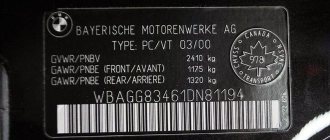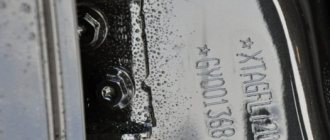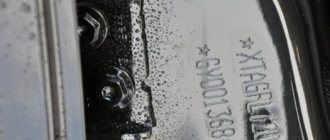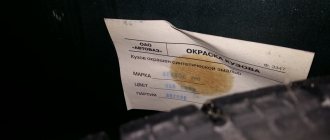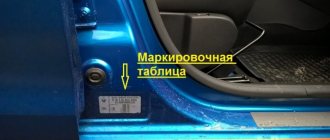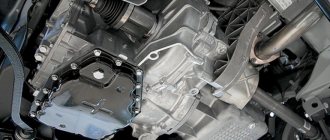Suspension and brakes
The Lada Vesta has a new MacPherson type front suspension, which is mounted on a subframe.
The engine mounts and the electric power steering rack are now mounted on it (previously it was located higher, which caused a lot of inconvenience). The independent suspension is equipped with L-shaped arms and steering knuckles, the angle of inclination of the axle turning the wheel is five degrees. This is a completely new solution for VAZ with telescopic shock absorbers (hydraulic or gas), springs and anti-roll bars. The Vestov chassis will give a head start to any foreign car in the middle segment. The rear suspension is semi-independent, spring with shock absorbers, borrowed from Renault Megane. All modifications of Vesta are produced with dependent rear suspension; AvtoVAZ plans to have an all-wheel drive vehicle; there is no exact release date yet.
The braking system of the car is liquid, disc brakes at the front, drum brakes at the rear. The Lada SV Cross has all disc brakes. The chain was completely taken from the Renault-Nissan concern.
↑ Innovations in painting
Attention! Modifications of Lada Vesta have a warranty against body corrosion from the manufacturer for 6 years. New technological methods and materials make it possible to achieve durable paintwork
New technological methods and materials make it possible to achieve durable paintwork.
The use of galvanic treatment of the body at the initial stage increased resistance to through corrosion by 10 times compared to the previous method. Cataphoretic primer means using tricationic phosphate as a protective film and adhesion using an electrolytic reaction.
Priming stages:
- degreasing;
- electroplating;
- rinsing;
- drying.
The degreasing process is carried out after cleaning the metal roughness in chambers or baths. To apply the phosphate layer, the product is immersed in a galvanic bath. A negative charge is applied to the metal parts; the primer solution is exposed to a positive charge. The phosphate compound settles on the body, forming a strong adhesion to the metal particles.
At the next stage, the body is washed in a bathtub or in a chamber. The final stage of priming is a drying chamber, after which the paintwork is applied to the car body. It is then dried, inspected and defects eliminated, after which the finished product enters the assembly line.
↑ Codes and names of colors
Lada Vesta color codes are numbered as follows:
- The pure white color is available as number 221, and is the only two-layer enamel produced without metallic and is completely free for the car owner.
- Blood red carnelian is produced under code 195.
- If you want to paint your car in Angkor brown, then know that its number is 246. The composition also includes metallic.
- Another option with metallic is the gray-beige “Carthage”. Issued under number 247.
- For lovers of dark blue shades, “Blues” is an ideal option. It also has a metallic finish and is released as number 492.
- The dusty blue-gray Phantom clearly contains a certain mystery. It is released under number 496 and, like almost all other shades, has a metallic in its color.
- For lovers of a pure gray shade, “Pluto” with metallic, produced under the number 608, was specially developed.
- One of the deepest shades is Black Pearl, also available in metallic. Paint number – 676.
- If you prefer silver tones, check out number 691. This color, additionally dusted with metallic, makes a lasting impression.
- Another indescribable option is a metallic silver called “Platinum”; Issued under number 691.
- Only the Cross model is available in orange. And this metallic shade is called “Mars” and is available as number 130.
As you can see, there is more than enough choice of shades here. And a domestic car can be painted in all these tones.
“Mars” or “Pluto”: colors of LADA Vesta
For the domestic automaker, Vesta became a real breakthrough and a sensation for Russian drivers.
Yes, initially it had quite a lot of problems, but the constant work of specialists made it possible to quickly get rid of them. Today Vesta is gaining enormous popularity not only in Russia, but also far beyond its borders. And in addition to the unique design, equipping the machine with modern systems and the use of technology, the manufacturer offered consumers a large selection of colors
However, it is important to remember that colors may differ slightly in real life, so do not blindly believe photos online
Lada Vesta – Blues color
A shade of blue that is darker than some manufacturers choose may appear black from a distance. The coating is suitable for those who prefer dark cars. Pros. It shines pleasantly in the sun, the color is deep and non-standard. Cons. A car of this color quickly heats up in the sun. Even minor scratches and damage stand out.
Reviews
Tamara: “I bought my son a blue-colored car - in the first six months the car lost its appearance, because the slightest branch leaves a scratch. It’s time to paint the body, although the car is not even a year old.”
Mark: “Solid beautiful color. It fits perfectly for this car. Calm, not conspicuous, and at the same time stands out for its originality.”
Timur: “I took the car in the spring – it’s cool, it looks good. But when summer came, I realized that the car should only be kept in the shade, because otherwise it would just be hot in the cabin.”
↑ White Lada Vesta advantages and disadvantages
Lada Vesta white is the most popular model in Russia and abroad. The glacial color in combination with black contours and body parts, tinted windows, and bright red rear lights gives the car an elegant and sophisticated style.
White color is one of the cheapest in the car color scheme. Other advantages create a preference for this shade:
- body contamination is less noticeable;
- it is easier to touch up the damaged surface;
- the car stands out on the road in daylight and dark.
The peculiarity of a snow-white car on the road is its neutrality
It does not irritate the eyes and does not distract attention
On a white body, traces of corrosion are more noticeable, which can be attributed to both disadvantages and advantages: it is cheaper and faster to deal with damage to the paintwork at the initial stage.
Lada Vesta is considered the most beautiful in the AvtoVAZ model range; the glacial version of the car has deserved increased attention. While maintaining recognizable details, such as x-stamping, the shape of the headlights, the model has a bright individuality in design
Positive reviews were earned by the smoothness of closing and opening doors, stability and maneuverability on any road, spacious interior, trunk and glove compartment
While maintaining recognizable details, such as x-stamping and the shape of the headlights, the model has a strong individual design. Positive reviews were earned by the smoothness of closing and opening doors, stability and maneuverability on any road, spacious interior, trunk and glove compartment.
Main technical characteristics of Lada Vesta:
- front-wheel drive;
- engine capacity 1.6 l or 1.8 l;
- 5-speed manual or robotic transmission;
- average maximum speed 180 km/h;
- maximum technical load 1.7 t;
- tank volume 55 l;
- acceleration time from 0 to 100 km 11-14 seconds;
- gasoline consumption is 6-8 liters per 100 km.
According to reviews from car owners, the disadvantages of the Lada Vesta are associated with such shortcomings as poor-quality gluing of plastic on the doors, rattling of the front mirror, inconvenient design of the cover in the engine compartment, lack of floor mats and fender liner protection. Complaints include the operation of the on-board computer, the multimedia system, the poorly thought-out design of the rear mudguards, the lack of smoothness in the robot's switching, and increased engine oil consumption.
Where is the body number of the Lada Vesta located and how is it deciphered?
The VIN number of the Lada Vesta body is a unique means of identification. No two numbers are the same. A set of letters and numbers contains encoded complete information about the car. This vehicle information is located on the right B pillar and under the hood, on the side of the engine compartment.
Externally, it is a plate on which the main information consists of seven lines. This:
- manufacturer (AvtoVAZ);
- vehicle type number;
- VIN number;
- permissible maximum weight;
- permissible maximum weight with trailer;
- permitted maximum load on the front axle;
- permissible maximum load on the rear axle.
The body number itself consists of 17 characters, including numbers and Latin letters. The first three characters are the manufacturer’s code, the fourth to ninth characters are the vehicle model, the tenth character is the encrypted year of manufacture, and the eleventh to seventeenth characters are the vehicle’s serial number.
Body appearance
Lada Vesta is a car that meets all modern standards. Technical characteristics and external design of the body are no exception. Increased (especially compared to its predecessors) strength and reliability are combined with style and beauty. The relatively recent modernization of AvtoVAZ has led to the fact that in all respects the Lada Vesta can compete with the best foreign-made cars. From a purely external perspective, it is worth noting a noticeable transition from the old design school to the new. The slightly daring and extravagant appearance of the car makes you turn around on the street. Some design details are borrowed from the Lada X Ray. For example, the central part of the front bumper, which looks like the letter X. The same outlines are repeated on the side surfaces of the body.
Today, new body types for this car brand are being developed. It is assumed that there will be six of them in total (to date, three have been put into production). In addition, we are talking about new body colors for the Lada Vesta cross and Lada Vesta sedan. Bright and dynamic “Lemon”, “Lime”, “Amethyst”, “Lapis Lazuli” and “Mystery” may soon appear on the roads of the country. Such shades should definitely attract the interest of the youth audience to the car.
Colors for LADA Vesta
You can buy Vesta in 10 different colors - there is a solution for every taste. You can choose from bright colors, muted tones, and pure shades. And all this is combined with the use of special mixtures and components that make the paintwork more resistant to scratches and fading.
Today the manufacturer offers the following color solutions for LADA Vesta models:
- Dark green "Krypton". The color appeared in 2022, it is characterized by both mutedness and special bright originality. The level and characteristics of lighting can play differently on paint.
- Red "Carnelian". Symbolizes energy and pace. It looks organic in different environments, has a rich hue and attracts a lot of attention. a rich shade that catches the eye in a gray environment.
- White "Glacial". The most popular color, non-metallic, inexpensive, two-layer enamel. Strict, perfectly emphasizes all the lines of the silhouette. Thanks to this tone, the black body parts stand out from the general background. But this color is quite capricious, since any imperfections are visible on it.
- Orange "Mars". Metallic. The shade was developed specifically for the new product. The color perfectly reflects the dynamics and originality of the car. It is considered the most spectacular enamel in the entire line.
- Black "Black Pearl". Strict and elegant metallic black with sophisticated chrome details. The car simply shines with gloss and aesthetics. This shade speaks of the respectability of the car owner, but it is demanding to handle - any imperfections, dirt, and dust are easily visible on it. But despite this, the color is quite popular.
- Brown "Angkor". One of the popular chocolate-colored metallics.
A brown car looks good in an urban setting. Successfully hides minor imperfections and dust, does not stain. Refers to the classic options, versatile and practical.
A blue car stands out favorably in a crowd of gray cars, gives an energetic appearance and speaks of the bright character of the owner of Vesta.
- Gray-beige "Carthage". Spectacular, solid and practical metallic, plays very interestingly in the sun. The shade evokes admiration and tranquility.
- Dark blue "Blues". It is called musical metallic, which resembles the color of the deep sea. A blue car stands out favorably in a crowd of gray cars, gives an energetic appearance and speaks of the bright character of the owner of Vesta.
- Silver "Platinum". Metallic resembles the color of the metal from which it gets its name. This color perfectly emphasizes the relief lines and silhouette, gives sharpness and clarity. The light shade adds airiness and lightness.
- Gray-blue "Phantom". This metallic speaks of the activity and dynamism of the model. The peculiarity of the shade is that it can change depending on the situation and in different conditions. At the same time, strict and laconic enamel shimmers in different shades of blue.
- Gray "Pluto". Metallic. Speaks of constancy, gives a feeling of confidence and reliability. It is the least easily soiled, and the graphite tone best demonstrates the outlines of the X lines on the doors.
The manufacturer offers Lada Vesta SV colors: sedan and station wagon in 9 shades. For SW CROSS, in addition to these 9 colors, you can order those developed specifically for this model - orange “Mars” and gray-beige “Carthage”. Vesta CNG can be purchased in three colors - Glacier, Black Pearl and Platinum. Depending on the chosen shade, you will have to make an additional payment: “Glacial” - no charge, “Carthage” 18 thousand rubles, all others - 12 thousand rubles.
↑ Let's look at several colors from the Lada Vesta collection
One of the most outstanding options is the Phantom. Actually, the name of the color here speaks for itself - it is a smoky blue, giving off a metallic look and bewitching with its nobility. This paint color of the Lada Vesta gives the car a noble appearance. Meanwhile, both young people and respectable people with their own business can pay attention to it.
When choosing a Lada Vesta body color, everyone is offered classic white as the base shade. At the same time, painting in glacial is completely free. This is a snow-white enamel that does not have a metallic sheen and is applied in two layers. This car looks stylish and bright at the same time. And as a contrast, alloy wheels and a roof can be used here, making the overall image of Vesta more sporty.
So which option is better to choose? If you love classics, but don’t want a boiling white car, then what color of Lada Vesta is best to choose? Perhaps the best option would be classic black. This tone will definitely add solidity to any car. “Black Pearl” is produced under number 676. And it got its name thanks to its pearly shine, which makes passers-by turn to look at the car.
Also, the color palette of the Lada Vesta suggests the presence of such an option as “Pluto”. This is a deep, very rich blue, which is complemented by metallic and as a result acquires a unique tone that changes depending on the viewing angle. This option is best suited for courageous people, self-confident and not afraid of such deep shades.
Lada Vesta black
Black cars are the most common on the roads. In the AVTOVAZ palette this tone is called “Black Pearl”. Looks solid on the road, suitable for any driver. Due to the high quality of the coating, you don’t have to worry about corrosion for 6 years or more. Pros. A classic that suits everyone. There will be no problems with the sale if necessary. Finding paint is not difficult. Cons
Even the smallest damages and scratches are very visible on black; maximum care must be taken to make the car look like new
Reviews
Kirill: “I have a black car, and as for me, this is the best option, especially for men. Looks solid."
Nikolai: “You constantly need to wash your car. Driving in the rain - welcome to the car wash. “Besides, the branches scratch a lot, my car is three months old and there are already several scratches on the body.”
Valery: “I like a black car, I’m now choosing what color to take the car, and I’m leaning towards this option.”
What you need to know about speed and acceleration
Speed is affected by vehicle size, engine power, gearbox, fuel type, tires, etc. WITH
Edan with a 1.6 engine and 5MT (manual transmission) reaches a maximum speed of 175 kilometers per hour, accelerates from 0 to 100 km in 11.2 seconds. With 5AMT (robot), the speed increases to 178 km/h, and acceleration, on the contrary, decreases by 1.9 seconds. The same sedan, with a 1.8 liter engine and 5AMT gearbox, has a maximum speed of 186 km per hour and accelerates to 100 km/h in 12.1 seconds.
The Lada SV with a 1.6 engine can accelerate to 174 kilometers per hour, and accelerate from zero to one hundred with a manual transmission in 12.4 seconds, with a robotic one in 14.4. A station wagon with a 122 hp engine. acceleration to 100 with a manual is 10.9 seconds (up to 180 km/h), with a robot 12.9 (up to 182 km/h).
Lada SV Cross is the slowest to accelerate. With manual transmission and 106 hp engine. the figure is around 12.6, with a 122 hp engine. - 11.2. With the 21179 engine and AMT, Vesta accelerates to 100 kilometers in 13.3 seconds. The speed limit is 172 (1.6, 5MT), 180 (1.8, 5MT) and 181 (1.8, 5AMT).
https://youtube.com/watch?v=Oo1cwbozQLs
↑ Painting features
As autobloggers and ordinary Lada Vesta owners tirelessly repeat in numerous reviews, AvtoVAZ masters have achieved significant success in developing the composition of auto enamel and inventing new colors. This fully applies to painting technology: cars “dressed” in silver, red carnelian, brown angkor or grayish shades have become more resistant to external influences (dust, dirt, moisture), and are simply much more representative and respectable than the usual “Lada” "
It is no coincidence that the plant includes in its list of warranty obligations a 6-year warranty for through body corrosion, namely, a high-quality paint coating protects against it.
The details of the technology itself, which is the author's development, are kept secret; it is only known that the basis of the enamel is an epoxy composition, which creates a high-quality and evenly distributed layer that successfully competes in strength with standard galvanizing.
Is the Lada Vesta body galvanized or not?
One of the most pressing questions that concerns motorists is whether the body of the Lada Vesta is galvanized. Especially if they have learned from the bitter experience of previous communication with the domestic auto industry. Previous AvtoVAZ cars began to rust and corrode quite quickly due to the fact that the body was not protected with zinc. It was frankly unprofitable. The car quickly lost its presentation and became vulnerable; regular anti-corrosion treatments and minor body repairs had to be carried out.
Fortunately for fans of the brand, the answer to the question whether the Lada Vesta has a galvanized body or not is yes. According to the manufacturer, these machines are very resistant to rust. It provides a guarantee against corrosion for up to six years. After this, he recommends carrying out additional treatment of the body yourself. This resistance to rust will make the car owner’s life much easier and reduce the cost of body repairs. A layer of metal covers absolutely the entire outer surface of the body. The only thing that can upset you is the method of applying zinc - the so-called “cold” one. This is the cheapest method, easy to use and not too expensive. But at the same time, it does not provide as reliable protection as more advanced methods. However, AvtoVAZ took care of additional protection. The internal cavities of the body are covered with an auxiliary layer of soil, and such vulnerable parts as arches, sills and the bottom are covered with a layer of anti-gravel. This composition prevents the appearance of chips, protects from impacts, from exposure to water and road chemicals, saving the metal from rotting and rusting for a long time.
Color spectrum
Initially, VAZ is targeting 9 shades, which the model will be painted in. It seems that this is very little, especially considering the mass of colors that cars sport, including models of the domestic concern. But this is a common practice of automobile companies, which always present a limited palette when releasing a new model. However, very soon it expands. This trend will be typical for Vesta.
So far, we can state the presence of 9 shades of Vesta, of which only 3 will be common with models of the Renault Nissan alliance, while the remaining 6 are considered original. Naturally, the starting palette will include the usual and popular colors - silver, black and white.
According to the preliminary version, these will be the following colors: black, white, blue, green, magma, red, pink, lilac.
And this is what these colors are officially called (marketing names):
- glacial (white)
- heartaholic (dark red)
- lime (bright green)
- phantom
- blues (dark blue)
- angkor (light brown)
- black pearl (black)
- krypton (dark green)
- platinum (silver)
- pluto (gray)
Let's sum it up
The variety of colors for the new Lada is amazing today. When next year the entire color palette is finally approved, and a sufficient volume of cars ready for sale appears in dealer showrooms, then it will be possible to loudly and without embarrassment declare that the domestic AvtoVAZ concern has reached a previously unattainable level in terms of bringing a new model to the market. In any case, the proposed range of shades is already attracting increased attention from the press to Vesta, which means it will attract new buyers.
Lada Vesta SV Cross dark blue blues – description
Those who have already seen a car in Blues color compare it to deep water, a pre-storm sky. It is as calm and peaceful as a pleasant, light blues.
For Lada Vesta Cross, the blues color is a middle ground between dark and light, it looks simple and hides thousands of shades. With each degree of illumination its features change. When creating the image of the Lada Vesta St Cross Blues, new enamels were used, as well as a specialized primer. It allows you to reliably protect your car from the adhesion of paints and metals. New paintwork will last a long time. The manufacturer guarantees it for six years; with the help of new technology, it was possible to make corrosion and rust a rare occurrence. The average paint thickness now reaches 135 microns, which is four times more than in previous versions. The coating has become more stable, thicker, and external influences no longer have the same impact as before.
Lada Vesta SV cross blue blues – pros and cons
Like all dark colors, Blues is very difficult to care for; it requires more frequent visits to the car wash than a silver or gray car. Separately, the manufacturer says that to wash the Lada Vesta Cross Blues, it is advisable to use high-quality chemicals and a contactless wash, since washing the car by hand can lead to micro-scratches.
This is perhaps the only drawback of this shade. As for the selection of paint and the painting procedure itself, the price for these services will be standard. The original color, which is distinguished by its depth, looks great, although it is called neutral.
Coating thickness
Despite the fact that the answer to the question whether the body of the Lada Vesta is galvanized or not is affirmative, someone may be wary of the thickness of the zinc coating. It is only 8 microns, which is not so much. However, such a layer should be enough to protect the car for five to six years even in the most unfavorable conditions. In addition, not only the zinc protects the body, but also the paintwork. It consists of three layers: primer, paint and varnish. The thicker this coating, the more durable and durable the car body will be. For Lada Vesta, the thickness of the paintwork on different parts of the body is:
- 125 microns on the trunk lid;
- 140 microns on doors;
- up to 128 microns on the roof;
- 104 microns on the hood;
- up to 144 microns on the wings of the wheel arches that are most vulnerable to rust.
For comparison, the thickness of the paintwork on most modern foreign cars is 100-150 microns. Consequently, Lada Vesta has excellent performance that meets all international standards.
↑ Features of carnelian color
Carnelian is a semi-precious stone of rich red-pink, yellow-red, orange-red deep shade. The carnelian color name means that this is not just a red car. Together with the shade, the unusual properties of the stone are conveyed to it, and the color itself has a complex structure.
Carnelian was revered by all nations and was used to make jewelry. The stone was believed to have magical properties:
- protects;
- gives strength;
- makes you fearless;
- pacifies.
The carnelian shade is a combination of mysterious depth and defiant shine. When painting the body, this effect is achieved through the use of metallic enamels. The car shimmers in the sun in a color range from orange to cherry.
The red range of colors has its own characteristics of impact on the human psyche. This is the most active, stimulating shade of the spectrum. It gives confidence in one's abilities and affects sexuality.
The orange tint improves mood and creates a favorable emotional background.
Yellow is a symbol of joy and fun. It affects brain function, improving memory and concentration.
Important! The combination of these shades in carnelian color promotes more confident behavior on the road and a general emotional mood, so that every trip brings pleasure to the owner of a car of this color
Thickness of paint coating (LPC)
So far, there is no exact information, but since AvtoVAZ is striving for world standards, we can say that the coating thickness will be from 75 to 160 microns. It is with this thickness of paintwork that about 95% of modern cars are produced.
You can determine the approximate thickness of the paintwork using the data available for other VAZ models. So, for Granta this figure is 98 microns, for Kalina it varies from 60 to 90 microns, while for Priora the spread is from 67 to 100 microns. The thickness of the paintwork for LADA Vesta will be approximately in this range.
The Lada Vesta car is one of the most popular among the AvtoVAZ model range. This is due to its modern design, numerous safety systems, and auxiliary devices for comfortable driving. The colors of the Lada Vesta also correspond to the high level of equipment of the model. Some shades appeared for the first time with the release of this particular car. And this is the merit of the new management of the Tolyatti concern.
The Lada Vesta body is painted using modern technologies. First, a layer of high-quality primer is applied to the galvanized metal using cataphoresis. This metal treatment process prevents corrosion from affecting it.
Live colors of the Lada Vesta Sport car
White (Glacial) - color code 221, painting method - two-layer enamel.
Red (Carnelian) - color code 195, painting method - metallic. Additional payment for color is 12 thousand rubles.
Carnelian color became available for sports versions of the car just recently, in June 2022.
Gray (Typhoon) - color code 616, painting method - metallic. Additional payment for color is 12 thousand rubles.
Black (Black Pearl) - color code 676, painting method - metallic. Additional payment for color is 12 thousand rubles.
Black Pearl, as well as the Carnelian color, were not available for the car in this version from the start of sales, however, a few days ago, the car’s equipment was updated and very soon you will be able to see the Lada Vesta Sport in black on the city roads.
Silver (Platinum) - color code 691, painting method - metallic. Additional payment for color is 12 thousand rubles.
Information about engines and oil consumption - in the simplest words
Vesta was supposed to be equipped with three engines. All Vestas are equipped with the Russian 21129 or the new 21279 (2016). The HR16 internal combustion engine from the Renault-Nissan concern with a maximum power of 114 horsepower did not appear. All three engines comply with Euro-5 class, are adapted for winter operation, and can work with several types of transmissions.
21129 - 106 hp engine. With. and a volume of 1.6 liters (1596 cubic centimeters), has 4 pistons arranged in a row. The maximum power is 5800 rpm, which is 78 kW. Maximum torque reaches 4200 rpm. min. This means that the maximum engine power develops at 4000 rpm, then fades out.
21279 - volume 1.8 with 122 horses, in-line, four-piston. This motor is capable of squeezing up to 5900 (90 kW) power revolutions and 3700 torque (170 N m).
Both engines are petrol with electronically controlled fuel injection. Gasoline with a 95 octane rating is recommended for them; Vesta can run at 92. The oil volume in the engines is 4.40 liters. Oil consumption, of course, depends on engine power. The manual Lada Vesta 1.8 “eats” more than the 1.6 liter engine, up to 1 liter per 1000 km. The owners noticed other numbers.

